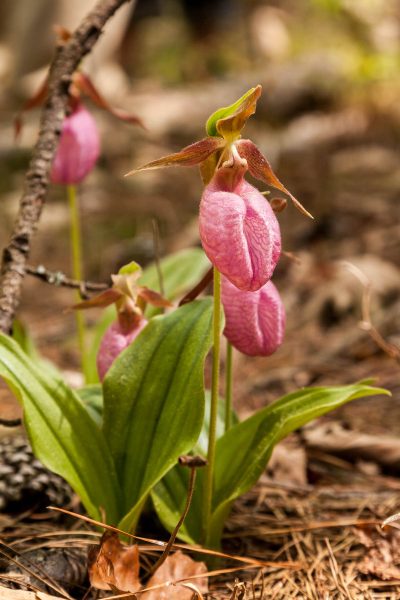Pink Lady's Slipper
Cypripedium acaule
The pink lady’s slipper, also commonly called a moccasin flower, is a native wildflower with a unique shape that can be found in wooded areas around North America.
This section shows one large critter image at a time. Use the thumbnails that follow to select a specific image to display here.

This gallery contains a grid of small thumbnails. Selecting a thumbnail will change the main image in the preceding section.
Appearance
The pink lady’s slipper is a native orchid that typically grows 6-15 inches tall. The plant has a skinny stem with one flower. Two basal leaves with parallel veins grow at the base of the stem. The flower ranges in color from a dark magenta to pale pink. The petals form a downward facing pouch that resembles a slipper or moccasin with a split in the front.
Reproduction and life cycle
The pink lady’s slipper flowers between late May and mid-July. This flower attracts bees with its color and sweet scent. Once the bee enters the flower pouch through the front slit, it becomes trapped and cannot exit the way it entered since the petals are turned inward. The bee exits through a different small opening in the plant. While moving through the flower, the bee rubs against the stigma (part of the female reproductive system of a flower) and any pollen the bee is carrying from other flowers pollinates the flower.
Bees will learn that this flower does not provide any nectar for them and soon will avoid the flower. This leads to the pink lady’s slipper having a low pollination rate. If the flower is pollinated, a small, brown seed capsule will form that holds thousands of tiny seeds.
This plant forms a symbiotic relationship with fungi which breaks open the seed and helps it grow. Once the seed has roots and becomes established, the plant will give nutrients to the fungi through its roots. A pink lady’s slipper will take many years to flower and reproduce and can live 20 years or more.
Did you know?
- This plant is one of the largest native orchids in the United States and there are over 58 different species in the genus that grow in the northern hemisphere.
- The pink lady’s slipper was used medicinally as a sedative in the 1800 and 1900s.
- Because pink lady’s slippers have a symbiotic relationship with a fungi that gives the plant nutrients, transplanting this flower is not often successful.
- In some places in the U.S. this flower is listed as threatened or has a “special concern” status so picking them in any location is discouraged.
Sources and additional information
- Plant of the Week: Pink Lady’s Slipper - U.S. Forest Service
- Plant Profile - USDA
- Flora Database - Flora of Newfoundland and Labrador
- Cypripedium acaule (Moccasin Flower, Pink Lady's Slipper) - North American Orchid Center
- Pink Lady Slipper Fact Sheet - University of Maine Cooperative Extension
